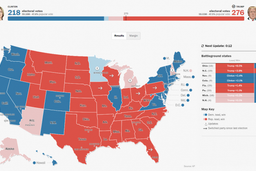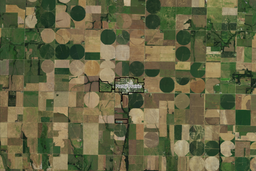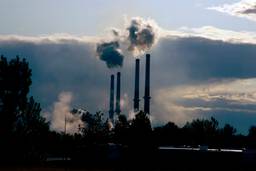America First, Planet be Damned: Trump Calls for Orgy of Extraction in North Dakota Energy Speech
John Collins
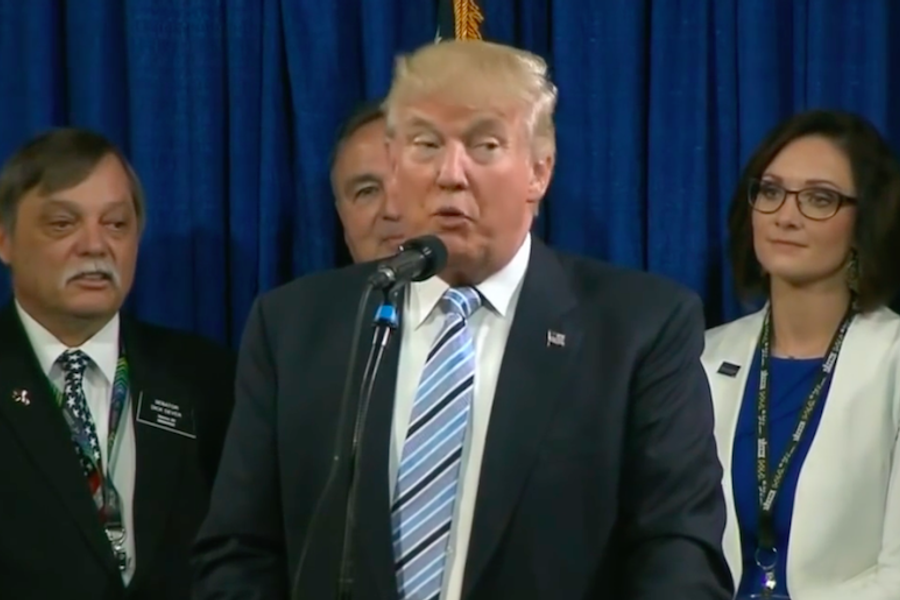
On May 26, shortly after North Dakota Republicans gave Donald Trump the final delegates he needed to officially clinch the party’s nomination, he delivered his first (scripted) energy policy speech at an annual oil and gas conference in Bismark, N.D. Beforehand, he held a press conference to take preliminary questions from reporters — a 40 minute teaser that drifted between his nicknames for opponents and his stance on fossil fuels.
All told, by the end of the day Trump had managed to reassure unemployed coal miners, praise farmers, ridicule Washington, offend Native Americans, pledge allegiance to the NRA, damn the EPA, resurrect the Keystone XL pipeline, fan the flames of smoldering Clinton conspiracy theories from the 1990s and remind everybody listening that he’s really good at business — all while promising energy independence once-and-for-all should he get elected.
Like any aspiring Republican barreling down the campaign trail, Trump repeatedly cited oppressive regulations as the source of America’s economic challenges, as well as the primary obstacle to inexpensive energy production. When asked, “What role do you think the federal government should have in regulating energy?” Trump responded: “I think the federal government should get out of the way. The federal government is in the way. We have so much potential energy that people wouldn’t even believe it.”
The familiar anti-regulatory mantra remains a crowd favorite, but perhaps especially among conservatives in financially struggling, energy producing states. North Dakota’s Bakken oil boom — the recent extraction of massive shale oil and natural gas reserves via hydraulic fracturing — began in 2006 and peaked in 2012. Revenue from the boom left the sparsely populated state with a billion dollar budget surplus in 2013 and residents earning 29 percent more than the national per capita average. But the global oil supply glut that began driving prices down in 2015 has caused many fracking operations to go offline, leaving thousands out of work. For better or worse, they’re expected to bounce back soon.
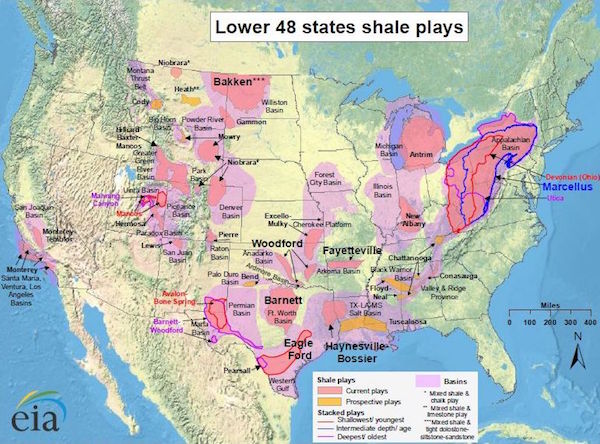
Shale formations containing significant accumulations of natural gas. (Image: energyandcapital.com)
The coal industry, it’s been widely reported, is not just facing a downturn — it’s “dying”. This has been happening for years but recent assessments suggest coal is fading even faster than projected. The United States produced 100 million fewer tons of coal in 2015 than 2014 with an even greater decline expected this year. In April, Peabody Energy, the world’s largest coal company declared bankruptcy. As the The Washington Post reported in March, this is occurring as 2015 global investment in renewable energy (largely wind and solar) surpassed, for the first time ever, the money spent on new coal, gas and nuclear plants. Much of this investment is taking place in developing countries — nations essentially skipping the coal phase of their own industrial revolutions — but increased investment in alternatives does not mean fossil fuels are going away any time soon. New plants are still being built alongside existing infrastructure here and abroad, and these operations have no intention of folding up shop before maximizing the return on their combustible investments, a process that could take decades.
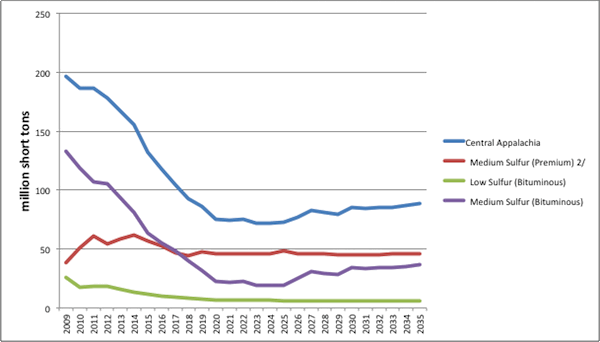
Energy Information Administration (EIA) graph depicting the projected decline of coal in Central Appalachia. (Image: wvpolicy.org)
Regulations, technology and global demand
While it’s true that the coal industry’s human and environmental safety record has subjected it to increasing regulations for generations, mines are closing in a multifaceted response to technological advancement, shrinking global demand as well as the EPA regulations put in place to accelerate their replacements. The Obama administration’s Clean Power Plan, which would impose even stricter limits on the coal industry, is currently tied up in the Supreme Court. If/when it’s implemented, there’s evidence to suggest its clean coal initiatives might be late to the funeral. Even China is expected to close 1,000 coal mines this year due to excess supply, making it fairly safe to assume that they will not be interested in buying any of ours for the foreseeable.
Trump, running as an “America First” nationalist, avoided talking about this global economic forecast and instead compared the centuries-long legacy of coal miners to his 2nd generation real estate empire. He also vowed to get their jobs back.
These miners, they’re incredible people. I asked some of them: Why don’t you go into some different profession? They said, “Because we love going after coal.” I’ll never forget the answer. You know, you think it’s dangerous — they’re going deep down into these incredible crevasses — I say wow, but they love doing what they do. That’s what they do. It’s like me. I grew up and my father was in real estate now I’m in real estate. … But with the coal miners, they love doing what they’re doing and it’s such an important product. Hillary Clinton should not be putting them out of business.
He was referring to a comment Clinton made at a town hall in Ohio in March acknowledging that her clean energy policies would “put a lot of coal miners and coal companies out of business.” She maintains the comment was taken out of context, but it’s since been seen as part of the reason why she lost West Virginia to Bernie Sanders. Coal miners — who for centuries have labored so the rest of us could take electricity for granted — do need help, but they are not the first to be “left behind” by a changing economic landscape, and they will not be the last. Ironically, the increased natural gas production that Trump favors is a key factor in the plummeting price of coal and subsequent mine closures.
A reporter from Wyoming, the largest coal producer in the United States, raised this point: “You’ve said many times that you’ll bring coal jobs back, but one of the main factors those jobs are going away and the mines are closing is because of low natural gas prices, poor decision making by coal companies and also because of slowing international demand. So do you believe you’ll actually have power, as the president, to bring those jobs back? And how?”
Trump replied:
I do because I think ultimately coal will be very inexpensive and you gotta get rid of some of the regulations. I spoke to some of the mine owners, and they were surrounded by some of the miners, and they were showing me some of the regulations where, on a daily basis, people are going in and checking, checking, checking — they have people who do nothing but deal with regulators — and it’s out of control. It’s gotten out of control.
The reporter pressed Trump on the second half of the question, asking, “And what would you do about the market forces?”
He replied:
The market forces are going to be whatever they are. All I can do is free up the coal. Which I’m going to totally do. I’m going to get the companies back to work. Market forces, that’s something I don’t want to get involved in. To me a market force is a beautiful force.
Again, this argument makes little economic sense in the context of coal, as encouraging other inexpensive forms of energy will only accelerate the industry’s decline, but if Trump can be persuaded not to get involved in “beautiful forces,” perhaps he can be persuaded not to hastily promote the unnecessary extraction of resources in and around what’s left of our nation’s undeveloped mountains, plains and waterways. That’s unlikely considering what he said in his speech:
America has 1.5 times as much oil as the combined proved resources of all OPEC countries. We have more natural gas than Russia, Iran, Qatar and Saudi Arabia combined. We have three times more coal than Russia. Our total untapped oil and gas reserves on federal lands equal an estimated $50 trillion. Think of that. We’re loaded. We didn’t even know it. We’re loaded. We had no idea how rich we were. We’re richer than all of them, folks.
Trump on fracking and solar:
Hillary Clinton and Bernie Sanders] want to knock out fracking — you do that and we’re going to be back in the Middle East and we’re going to be begging for oil again. It’s not gonna happen. Not with me. We’re going to open up, we’re going to be energy independent — all sorts of energy, everything you can think of, including solar. And I know a lot about solar. The problem with solar is it’s very expensive, you know, when you have a 30 year pay back that’s not exactly the greatest thing in the world. But I know a lot about solar and I’ve gone solar on occasion but it’s a very, very expensive thing.
Despite receiving millions in federal subsidies, many solar companies have also filed for bankruptcy in recent years. But Trump’s experience with wind and solar energy appears largely rooted in decisions regarding his casinos, hotels and golf courses. While he’s right that commercial solar installation is still expensive, many economists believe it is only a matter of time before it overtakes coal and rivals oil as the planet’s primary source of energy. Politically motivated investments have so far failed to back what’s best for the long-term sustainability of the solar industry, but the next administration (preferably one even semi-liberated from the influence of fossil fuel lobbyists) could theoretically learn from past mistakes, prioritize smaller projects that work for consumers and facilitate a more effective transition that provides long-term employment options. The costs of producing and storing solar energy are only going down from here on out.
Activists involved in the sustainability movement, meanwhile, continue to advocate for allowing communities, not energy corporations, to decide what gets drilled, blasted or sucked out of the ground. In other words, energy policies not written by oil and gas executives.
Trump on wind energy:
Wind is very expensive. Without subsidies wind doesn’t work. You need massive subsidies for wind. And there are places, maybe, for wind, but if you go to various places in California wind is killing all of the eagles. You know, you shoot an eagle, you kill an eagle and they want to put you in jail for five years and yet the windmills are killing hundreds and hundreds of eagles — one of the most beautiful, one of the most treasured birds — they’re killing them by the hundreds and nothing happens. So wind is a problem. Plus it’s very, very expensive and doesn’t work without a subsidy. Despite that, I am into all types of energy.
According to Save the Eagles International, a global alliance of bird enthusiasts and ornithologists, wind turbines are killing an alarmingly large number of birds and bats annually. Other (less esoteric) sources, however, dismiss this claim as totally untrue—adding that dogs and cats actually kill more birds than wind turbines do. Trump is correct that wind energy has thus far required massive subsidies but he failed to acknowledge its rising status on the world energy stage. It’s estimated that wind’s renewable potential could provide more than enough energy to meet the planet’s needs. Post-installation operational costs are low (like solar), installation prices continue to drop (as much as 80 percent since 1980) and the means to harness wind can be implemented almost anywhere. On the other hand, turbines are no fun to live around.
Trump on Native issues and tribal sovereignty:
Trump continued to accuse Sen. Elizabeth Warren (D-Mass.), who he’s taken to calling Pocahontas, of faking Native American heritage to get ahead academically and politically. Upon using the nickname and getting a negative reaction from people in the room, Trump feigned sympathy, asking, “Oh, is that offensive?” To which one reporter audibly replied, “Yes, it’s offensive.” Trump rolled his eyes and continued.
A few moments earlier, when asked, “Are you planning on recognizing tribal sovereignty, on a nation to nation basis, based upon the UN declaration on the rights of indigenous peoples which the United States had endorsed?”
Trump replied that he’s not sure yet:
I’m going to have to look at it individually and I will be doing that. A number of people have asked me, and I will be doing that. Ok?
Trump on the Paris climate agreement
President Obama entered the United States into the Paris Climate Accords unilaterally and without the permission of Congress. This agreement gives foreign bureaucrats control over how much our energy and how much we use right here in America — so foreign bureaucrats are going to be controlling what we’re using and we’re doing on our land, in our country. No way. No way.
These actions have denied millions of Americans access to the energy wealth sitting right under our feet — wealth we didn’t even know we had five years ago, ten years ago. This is your treasure. And you — the American people — are entitled to share in the riches.
A Trump administration will focus on real environmental challenges, not the phony ones that we’ve been looking at….We’ll solve real environmental problems in our communities, like the need for clean and safe drinking water.
In a Trump administration, political activists with extreme agendas will no longer write the rules — because that’s what’s happening now. Instead we will work with conservationists whose only agenda is protecting nature — that’s fine. From an environmental standpoint, my priorities are very simple: clean air and clean water. Right?
Here, Trump makes it clear that he sees no pressing need to cut carbon emissions — that he views recent global efforts to combat climate change as a foreign policy blunder and tax scam that’s cheating hardworking Americans out of prosperity — while at the same time implying that his vision for a less regulated fracking industry is wholly consistent with his passion for a more fair economy and clean drinking water. This is problematic because fracking is a boom and bust ecological nightmare — directly responsible for contaminated drinking water, the release of cancer-causing particulates into the air around job sites, earthquakes, oil spills and cycles of high unemployment in rural communities all over the country. France, Germany, Scotland and Bulgaria have enacted countrywide bans on the practice. The round grained silica “frac sand” the natural gas industry prefers for easiest extraction, furthermore, threatens prime farmland in the Upper Midwest as well as the Great Lakes (some of the cleanest water on the planet).
Trump on agriculture:
Cheaper energy will also boost American agriculture. We’ll get the bureaucracy out of the way of innovation so that we can pursue all forms of energy. This includes renewable energy and the technologies of the future. It does include nuclear and wind and solar, but not to the exclusion of other forms of energy that right now are working much better. The government should not pick winners and losers, instead it should remove obstacles to exploration.
He added:
While we’re in North Dakota, I have to say this: I love the farmers and the farmers are incredible. We have to remember that this was largely a farm state and they produce tremendous crops of tremendous different goods of which I eat a lot of them.
While the petroleum dependent fertilizer industry will no doubt approve of Trump’s all-in approach, its affect on “tremendous different goods” (biodiversity) and public health is anything but good news for organic farmers and sustainably-minded consumers. But then, such citizens are clearly not Trump’s target demographic.
(Editor’s note 5/31: While attempting to write a more tidy conclusion to the above post — something philosophical about what Donald Trump’s success as a candidate says about the country—Trump’s popularity inexplicable…says Stephen Hawking started trending online and I lost my nerve. Please feel free to add your own in the comments below. JC)


